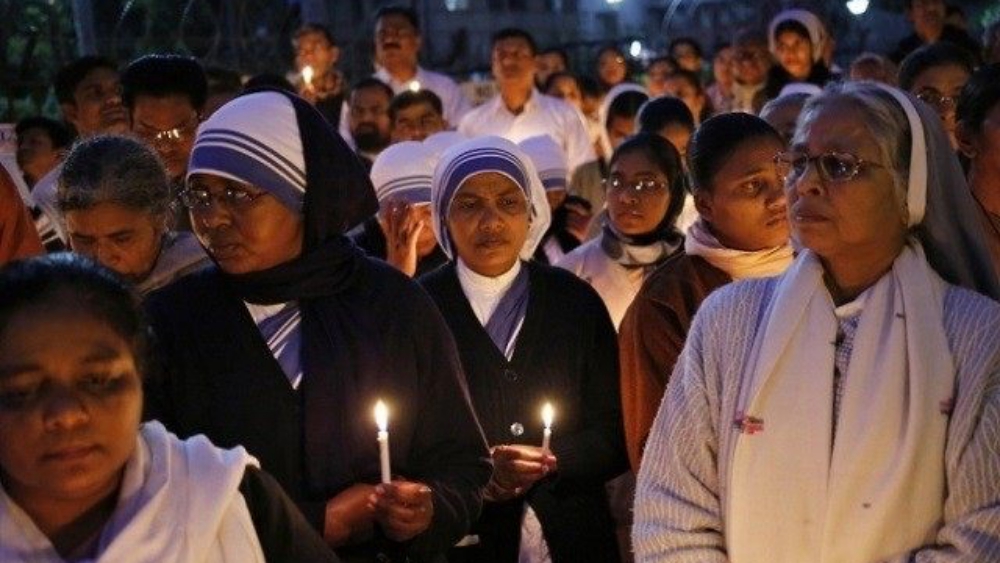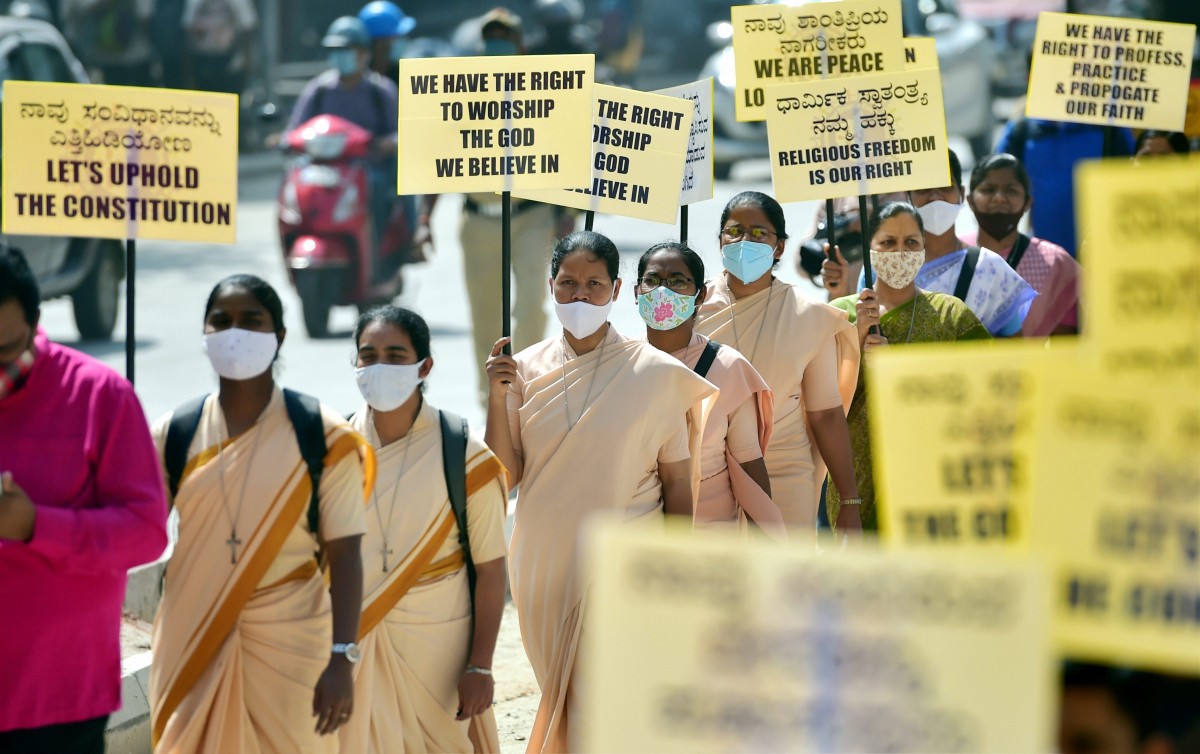The Bogey of 'Forced Conversions' Has Long Diverted Us from the Realities of Indian Christians
On August 8, six Dalit Christian women were arrested by police in Uttar Pradesh's Azamgarh on charges that they were forcefully converting people of the Hindu faith into Christianity. The police acted on a complaint filed by a Vishwa Hindu Parishad (VHP) member who accused them of "luring others with money" to take up the Christian faith.
What happened in Uttar Pradesh is nothing new or unusual, nor will it be the last such incident. Be it Uttar Pradesh, Karnataka, or anywhere else in the country, Hindutva outfits are ever ready to cry wolf over what they call "forced conversions" or "forced mass conversions".
Also read: Over 300 Instances of Violence Against Christians Were Reported in Nine Months of 2021: Report
Every time the question of someone accepting the Christian faith comes to the fore in India, even the popular perception is that the person concerned has converted either only under duress or due to some inducement. This view is not just held by zealous Hindu fundamentalists, who unleash violence on members of the Christian community, but even by those who swear no allegiance to the Hindutva ideology. In popular parlance, therefore, the word 'converted' assumes a pejorative connotation, for the crossover to the Christian faith in India is always believed to have taken place unconsciously and unwillingly by converts.

A March 25, 2015 photo shows a protest against anti-Christian violence in the country. Photo: Reuters
At one level, the reason for such a view to gain currency is the myth peddled by the anti-Christian brigade which alleges that mass conversions would result in a sizeable number of Hindus accepting Christianity. On the other hand, implicit in such a view is a casteist angle, the perception of it being a "foreign religion", and the ignorance of the evolution of the faith and its contemporary form in India.
Dent to the Hindu demography?
The view that mass conversions are affecting the preponderance of Hindus in the country is a factoid rather than a fact.
According to the data available from Census, the size of the Christian community relative to the country's population has either been static or been on the decline since 1971. The 1971 Census estimated that Christians accounted for 2.6% of India's population. By 2001, this figure dropped to 2.3%. While the religious composition of 2011 Census figures has never been released, leaked data has shown that there has been a further decline in the size of the community.
On the contentious issue of religious conversion, a Pew research report released in June 2021, notes that it is "rare" for someone in India to make a switch from one religion to another.
"An overall pattern of stability in the share of religious groups is accompanied by little net change from movement into, or out of, most religious groups. Among Hindus, for instance, any conversion out of the group is matched by conversion into the group," the report underlines.
The report was based on a survey carried out among nearly 30,000 Indians from various religious backgrounds. "Among Hindus, for instance, any conversion out of the group is matched by conversion into the group: 0.7% of respondents say they were raised Hindu but now identify as something else, and roughly the same share (0.8%) say they were not raised Hindu but now identify as Hindu," the report notes.
Also read: 'Complicity of Police; Forced Conversion a Myth': PUCL on Attacks on Christians in Karnataka
However, these estimates still do not convince many about the myth of mass conversions. Nobody, including Christians themselves, believes the official figures, nor what surveys portray on the size of the community in the country. This is because a large number of them are crypto Christians, for they officially present themselves as Hindus while practicing their Christian faith privately. This dual identity is essential for Christians populating India's hinterlands to face a host of social and economic challenges that arise from the time they accept the Christian faith.
Even if we were to include the crypto Christians, the population size of the community would still not be anywhere near what the peddlers of the mass conversion myth portray. According to statisticians Todd Johnson and Kenneth Ross, Christians account for 4.8% of India's population. Some, including Jason Mandryk, puts it at 5.84%. At best, the community in India can be termed as a mini or minuscule minority, relative to other minority religious groups.
However, for many Indians, their flawed perceptions about the community blind them from seeing the reality on the ground. As a result, they make outlandish claims and raise a false alarm about the Christian "missionary mafia" taking over India.
For instance, recently an English-educated upper caste Hindu young man from a metro city, who presented himself as a liberal ('I-have-Christian-and-Muslim-friends'), told this writer that Andhra Pradesh chief minister Y.S. Jagan Mohan Reddy (a practicing Christian) was giving Rs 50,000 per person in his state to convert Hindus into Christianity. Not only is this a falsehood, but it is laughable, for it even defies any common sense. It is surprising that a politician as shrewd as Reddy would be more interested in increasing the headcount of Christians by putting his political future at stake at a time when extra vigilant Hindutva outfits are eagerly ready to expose any such attempts. In reality, such a view is reflective of the contempt a large section of our society has for a practicing Christian who is a chief minister.
This anti-Christian sentiment, therefore, is not just confined to Hindu fundamentalists but runs deep in our society, portraying Christians as a community whose sole purpose in their lives is to proselytise and see their numbers grow.

Members of Christian community and supporters hold placards during a protest rally against the Anti-Conversion bill, which was tabled yesterday during the Winter Session of Karnataka Legislative Assembly, in Bengaluru, Wednesday, Dec. 22, 2021. Photo: PTI.
Social realities of the community
This suspicious and contemptuous view of the community is also reflected in various judgments and laws passed in Independent India. From 1977 when the Supreme Court in Rev Ft Stanislaus v State of Madhya Pradesh case upheld Madhya Pradesh's anti-conversion law to a string of such laws enacted in 14 Indian states with more teeth recently, the practice and propagation of Christian faith in India can attract criminal charges. The fact these laws clearly violate Article 25 of the Indian constitution which allows individuals the liberty to profess, practice and propagate their religion freely does not seem to apply in the case of the Christian community.
Also read: India 10th Most Dangerous Country to Live in for Christians: Report
Whether by design or otherwise, such laws are paradoxically called the 'freedom of religion act' in most states where such laws exist. Something as simple and private as accepting and practicing faith now requires potential converts to go through a convoluted bureaucratic process. They now have to give advance notice to district magistrates explaining the 'real intent' behind such conversion. The proof of burden strangely rests with the person who wishes to convert rather than with those who accuse them of "forced conversion". Failing to do so can attract criminal charges which make it a non-bailable offence, requiring them to cough up hefty penalties and serve jail terms.
The rising attacks against Christians can be safely described as attacks on Dalits and the marginalised of this country. As many as 74% of Indian Christians belong to lower castes, and Dalits and Tribals together account for 57%. Given that Dalits who accept Christianity are stripped of their access to reservations as they lose Scheduled Caste status (only officially, but socially still face the humiliation as Dalits), they face double discrimination both for their faith and their social location.
What many get wrong about Indian Christianity today is that they still view it as a 'foreign religion', relying excessively on overseas contributions for its survival. However, a large part of the contemporary Indian Church has long delinked its connections with the West.
A number of churches and prayer halls in remote parts of India do not in any way claim association with any pope or papacy, or any diocese or archbishop. They are established with limited means pooled in from the small faithful congregations in their own villages. All they can promise is a sense of community and spiritual well-being but nothing in terms of material benefits (inducements). Most of them hold prayer meetings in makeshift tents or tin-roofed rooms, reflecting their own socio-economic conditions. No doubt large-scale Christian organisations still do exist, but their hold and influence on the Indian Christian community have declined greatly.
This is because these charismatic or new-age churches are an outward projection of the democratisation that has taken place in the Indian Christendom. Unlike in Hinduism where the priesthood is still an exclusive privilege of one community, in Christianity, one does not have to belong to or have a certain level of educational qualifications to become clergy in their churches. Often, they empower men and women of all age groups and social statuses to interpret the Biblical doctrine and preach to their brethren in their local language and idiom and connect it to their own physical world. However, one must also bear in mind that this is limited to the spiritual realm while their social lives are still plagued by caste realities.
Therefore, in reality, the bogey of mass conversion is indicative of collective frustration and insecurity on the part of Hindutva outfits at the perceived injustice to and rejection of the Hindu faith by some converts. The stark reality, however, is that Christianity in India in no way poses a threat to the demographic and philosophical might of Hinduism. But the political ideology of Hindutva leverages this paranoia for electoral purposes to consolidate Hindus (often divided along caste lines) in the name of religion.
This article went live on August seventeenth, two thousand twenty two, at thirty minutes past three in the afternoon.The Wire is now on WhatsApp. Follow our channel for sharp analysis and opinions on the latest developments.





